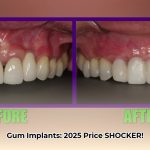Discovering a hole in your gum tissue can be alarming. This comprehensive guide provides a detailed understanding of the potential causes of gum holes, how to identify them, available treatment options, and effective preventative measures. From common culprits like periodontitis to less frequent causes such as infections and injuries, this resource aims to empower you with the knowledge to proactively manage your gum health and seek appropriate professional care. For more on gum sensitivity, check out this helpful article on gum sensitivity.
Understanding Gum Holes: A Detailed Overview
A hole in your gum, regardless of its size, warrants attention. It almost always indicates an underlying issue affecting the health of your gums and potentially the supporting structures of your teeth. Understanding the specific cause is crucial for effective treatment and prevention. Let’s explore the potential reasons behind these gum defects and how to address them.
Common Causes of Gum Holes
-
Periodontitis (Advanced Gum Disease): The most frequent cause of holes in the gums. Periodontitis arises from untreated gingivitis. Plaque, a sticky film of bacteria, accumulates on teeth. If not removed regularly through brushing and flossing, it hardens into tartar (calculus). The bacteria in plaque and tartar irritate the gums, leading to inflammation (gingivitis). Over time, this inflammation spreads below the gum line, destroying the soft tissues and bone that support the teeth, creating pockets or holes.
-
Infections: Viral or bacterial infections can also lead to gum holes.
- Herpetic Gingivostomatitis: Commonly seen in children, this infection caused by the herpes simplex virus (HSV) can create painful ulcers and lesions on the gums that appear as holes.
- Actinomycosis: A rare bacterial infection that, in severe cases, can affect the mouth and jaw, leading to gum lesions.
-
Tooth Extraction: The socket left after a tooth is extracted is essentially a hole in the gum. This is a normal part of the healing process and will gradually fill in with bone over time. However, complications can occur if the socket is disturbed (e.g., dry socket).
-
Necrotizing Periodontal Disease (NPD): A severe and rare form of gum disease characterized by rapid tissue death (necrosis). NPD is most often seen in individuals with compromised immune systems. The gums may appear cratered or punched out, with painful ulcers and a grayish membrane covering the necrotic areas.
-
Trauma: Physical trauma to the gums, such as from a sharp object or injury, can result in a hole or laceration.
Recognizing the Signs: Identifying Gum Problems Early
Early detection is key to preventing the progression of gum disease and minimizing damage. Be aware of the following warning signs and seek professional dental evaluation if you experience any of them:
- Bleeding gums during brushing or flossing: Even a small amount of blood is a sign of inflammation.
- Persistent bad breath (halitosis): Often caused by bacteria accumulating in gum pockets.
- Red, swollen, or tender gums: A clear indication of inflammation.
- Receding gums: Gums pulling away from the teeth, exposing more of the tooth root.
- Loose or shifting teeth: A sign of significant bone loss.
- Pain when chewing.
- Pus or discharge between the teeth and gums: Indicates an infection.
- Changes in the way your teeth fit together when you bite.
- Increased sensitivity in teeth.
Diagnosis and Treatment Options
A thorough dental examination is necessary to determine the cause of a gum hole and to develop an appropriate treatment plan. Your dentist will:
- Visually examine your gums for holes, pockets, inflammation, and recession.
- Measure the depth of any pockets around your teeth using a periodontal probe. Deeper pockets indicate more severe gum disease.
- Take X-rays to assess the extent of bone loss supporting your teeth.
- Review your medical history and lifestyle factors (e.g., smoking, diabetes) that may contribute to gum problems.
Treatment options vary depending on the cause and severity of the gum hole:
-
Professional Cleaning (Scaling and Root Planing): A deep cleaning procedure to remove plaque and tartar from above and below the gum line. Scaling removes the buildup, while root planing smoothes the tooth roots to help the gums reattach. This is often accompanied by local anesthesia.
-
Antibiotics: Oral or topical antibiotics may be prescribed to combat bacterial infections.
-
Periodontal Surgery: In more advanced cases, surgery may be necessary to repair damaged tissues and bone.
- Flap Surgery (Pocket Reduction Surgery): The gums are lifted away from the teeth to allow access to the deeper areas for cleaning. The gums are then sutured back in place, reducing the size of the pockets.
- Gum Grafting: Used to cover exposed tooth roots caused by gum recession. Tissue is taken from another area of the mouth (usually the palate) or a tissue bank and grafted onto the affected area.
- Bone Grafting: Used to regenerate bone that has been lost due to periodontitis. Bone grafting material is placed in the affected area to stimulate new bone growth.
- Guided Tissue Regeneration (GTR): A membrane is placed between the gum and bone to prevent the gum tissue from growing into the bone defect, allowing bone to regenerate.
-
Treatment of Underlying Infections: If the gum hole is caused by an infection (e.g., herpetic gingivostomatitis), antiviral medications or other appropriate treatments will be prescribed.
-
Tooth Extraction and Socket Preservation: If a tooth is beyond saving, extraction may be necessary. Socket preservation techniques (e.g., bone grafting) can help to minimize bone loss after extraction and prepare the site for future dental implants.
Prevention: Your Best Defense Against Gum Holes
Preventing gum holes is more effective and less costly than treating them. The following steps are essential for maintaining healthy gums:
-
Practice Excellent Oral Hygiene:
- Brush your teeth twice daily for two minutes each time with fluoride toothpaste. Use a soft-bristled toothbrush and gentle, circular motions.
- Floss at least once a day to remove plaque and food particles from between your teeth and under the gum line.
- Use an antimicrobial mouthwash to help kill bacteria and reduce plaque.
-
Maintain a Healthy Diet:
- Limit sugary and starchy foods, as they contribute to plaque formation.
- Eat a balanced diet rich in vitamins and minerals to support healthy gums.
-
Schedule Regular Dental Checkups and Cleanings:
- Visit your dentist every six months for professional teeth cleanings and checkups. Your dentist can detect early signs of gum disease and provide treatment before it progresses.
-
Avoid Smoking and Tobacco Use:
- Smoking is a major risk factor for gum disease. Quitting smoking is one of the best things you can do for your oral and overall health.
-
Manage Systemic Health Conditions:
- Conditions like diabetes can increase your risk of gum disease. Work with your doctor to manage these conditions effectively.
-
Reduce Stress:
- Stress can weaken your immune system and make you more susceptible to gum disease. Find healthy ways to manage stress, such as exercise, meditation, or spending time in nature.
Understanding Risk Factors for Gum Disease
Certain factors can increase your risk of developing gum disease and, consequently, gum holes:
- Smoking or tobacco use.
- Diabetes.
- Genetic predisposition.
- Poor oral hygiene habits.
- Certain medications (e.g., some blood pressure medications, antidepressants).
- Hormonal changes (e.g., pregnancy, menopause).
- Weakened immune system (e.g., HIV/AIDS, autoimmune diseases).
- Stress.
- Clenching or grinding your teeth (bruxism).
- Poor nutrition.
Addressing Common Questions (FAQ)
-
Q: How long does it take for a gum hole to heal?
- A: Healing time varies significantly depending on the cause and the treatment received. A simple extraction socket may heal in a few weeks, while more complex periodontal surgery can take several months.
-
Q: Can gum holes heal on their own?
- A: In most cases, no. Gum holes caused by periodontitis typically require professional treatment to heal properly. While the body can heal minor injuries, the underlying infection and tissue damage associated with periodontitis need to be addressed by a dentist.
-
Q: What are the long-term effects of untreated gum disease?
- A: Untreated gum disease can have serious consequences, including tooth loss, bone loss, receding gums, and increased risk of other health problems such as heart disease, stroke, diabetes complications, and pregnancy complications.
-
Q: Is gum disease contagious?
- A: While gum disease itself isn’t directly contagious like a cold, the bacteria that contribute to gum disease can be transmitted through saliva. This means that sharing utensils, kissing, or other activities that involve saliva exchange can potentially spread the bacteria to others.
Actionable Steps for a Healthier Smile
- Commit to a Consistent Oral Hygiene Routine: Brush twice daily, floss daily, and use an antimicrobial mouthwash.
- Schedule Regular Dental Appointments: Don’t skip your checkups and cleanings.
- Adopt a Healthy Lifestyle: Eat a balanced diet, manage stress, and
- Unlock Young Doctors’ Work-Life Balance: Actionable Strategies Now - December 2, 2025
- Unlock Life Harmony: Work-Life Integration Guide - November 30, 2025
- Unlock Work-Life Harmony:Your Guide to Integration - November 27, 2025
















